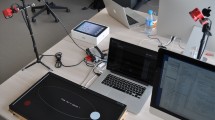Abstract
In many user interfaces with restricted input capabilities, a time-out is used to automatically change the user interface (UI) from one mode to another. In this paper, we study the learning of time-outs and the effect of feedback on it in the case of mobile phone text entry. The effects of three different feedback schemes (auditory/visual/no feedback) on the learning of two different time-out lengths were compared. We measured the response time (RT) from the time-out occurrence to the time of the user’s action. Error rates and the development of the RTs in different schemes were used as measures of learning. We also studied if the users learned to estimate the time-out lengths, or if they just reacted to the available feedback. There were three main findings. Without feedback, RTs had a great variation. Auditory feedback enabled faster RTs than visual feedback. Finally, we found evidence of short-term learning, but not much of a lasting effect. The possible application of adapting time-out length to user RT is discussed.




Similar content being viewed by others
References
Jacob RJK (1991) The use of eye movements in human–computer interaction techniques: what you look at is what you get. In: ACM T Inform Syst (TOIS) 9(2):152–169
Wilson A, Shafer S (2003) XWand: UI for intelligent spaces. In: Proceedings of the conference on human factors in computing systems, Ft. Lauderdale, Florida, April 2003. ACM Press, pp 545–552
ETSI Human Factors (HF) (1996) Assignment of alphabetic letters to digits on standard telephone keypad arrays. ETS 300640. European Telecommunications Standards Institute
Deutsch D (1999) The processing of pitch combinations. In: Deutsch D (ed) The psychology of music, 2nd edn. Academic Press, San Diego
Levitin D, Cook PR (1996) Memory for musical tempo: additional evidence that auditory memory is absolute. Percept Psychophys 58:927–935
Näätänen R, Muranen V, Merisalo A (1974) Timing of expectancy peak in simple reaction time situation. Acta Psychol 38:461–470
Myers BA (1985) The importance of percent-done progress indicators for computer–human interfaces. In: Proceedings of the SIGCHI ’85 conference on human factors in computing systems, San Francisco, CA, April 1985
Teal SL, Rudnicky AI (1992) A performance model of system delay and user strategy selection. In: Proceedings of the SIGCHI ’92 conference on human factors and computing systems, Monterey, California, May 1992. ACM Press, New York, pp 295–305
O’Donnell P, Draper SW (1996) Temporal aspects of usability: how machine delays change user strategies. SIGCHI Bulletin, vol 28
Silfverberg M, MacKenzie IS, Korhonen P (2000) Predicting text entry speed on mobile phones. In: Proceedings of the ACM conference on human factors in computing systems CHI 2000, The Hague, Amsterdam, April 2000. ACM Press, New York, pp 9–16
Ronkainen S, Marila J (2002) Effects of auditory feedback on multitap text input using standard telephone keypad. In: Proceedings of the 8th international conference on auditory display, Kyoto, Japan, 2–5 July 2002, pp 125–129
Woodson WE, Tillman B, Tillman P (1992) Human factors design handbook, 2nd edn. McGraw-Hill, New York, pp 630–631
Acknowledgements
We would like to thank Mr. Miika Silfverberg for providing information on adaptive time-out.
Author information
Authors and Affiliations
Corresponding author
Rights and permissions
About this article
Cite this article
Marila, J., Ronkainen, S. Time-out in user interface: the case of mobile text input. Pers Ubiquit Comput 8, 110–116 (2004). https://doi.org/10.1007/s00779-004-0264-0
Received:
Accepted:
Published:
Issue Date:
DOI: https://doi.org/10.1007/s00779-004-0264-0




